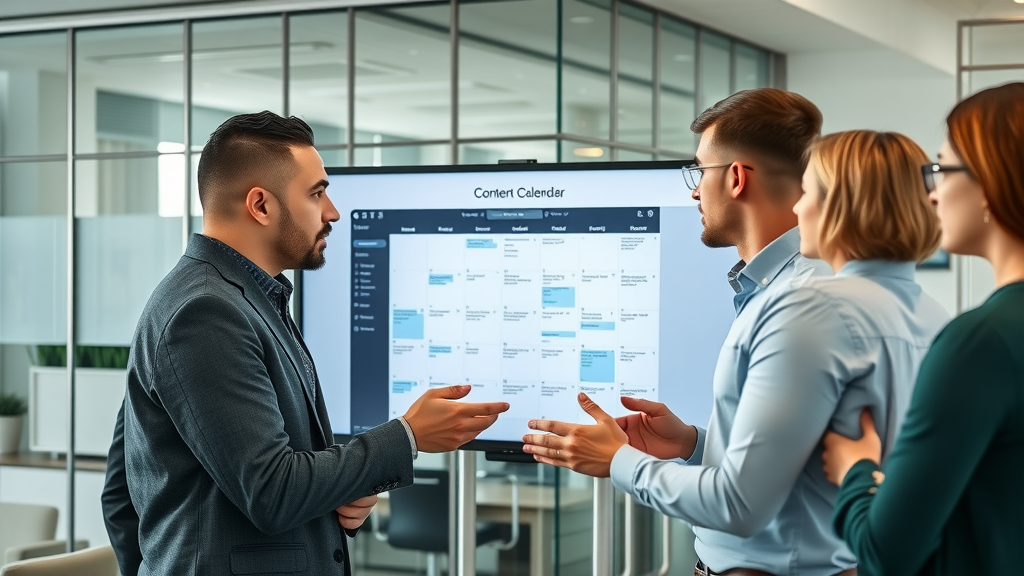Imagine this: over 90% of online content never makes it to Google’s first page . If you want your blog post or business website to stand out and rank high on search results, you need more than good writing—you need SEO content optimization . This guide reveals actionable tactics, data-driven insights, and step-by-step instructions that will help you leapfrog your competition and achieve maximum visibility in search engines. Unlock the secrets experts use and start ranking higher today.
Astounding SEO Content Optimization Facts That Will Change Your Approach
The digital landscape is incredibly competitive, and recent studies reveal that a staggering 90% of all published web content fails to appear on the first page of search engine results. This means that most of what we publish never gains the traction or visibility it deserves. Competing for those coveted spots requires a strategic approach to SEO content optimization —one that aligns with both user intent and search engine ranking criteria.
Modern search engines have become remarkably sophisticated, moving beyond basic keyword matching to understand the context, quality, and authority of your content. Websites that employ advanced content optimization techniques—like clear topic structuring, robust internal links, and compelling meta descriptions—consistently outperform their peers. Optimized content strikes a critical balance between subject matter expertise and technical structure that helps your site rise through the ranks.

Did You Know? Over 90% of Online Content Fails to Reach the First Page of Search Engines
This jaw-dropping statistic should be a wake-up call for anyone involved in creating website content. If you aren’t optimizing for search engines, your content may as well be invisible to your target audience. By embracing effective SEO content optimization strategies, you put your site in the best position to be discovered and engaged by your audience—while those who ignore these facts are left behind in the digital shadows.
Mastering SEO Content Optimization: What You’ll Gain
- A complete understanding of seo content optimization for top rankings
- Proven strategies for creating and optimizing content
- Insights into effective keyword research and on-page tactics
- Actionable steps to enhance your content marketing and featured snippets
- Practical checklists and real-world examples

SEO Content Optimization Essentials: Laying the Groundwork for Optimized Content
Defining SEO Content Optimization and Its Role in Modern Search Engines
SEO content optimization is the process of refining your web content to make it highly relevant, keyword-targeted, and easily understood by search engines. At its core, it’s about making sure your pages answer specific queries effectively while leveraging technical SEO elements like title tags , meta descriptions , and internal links . In today’s search environment, engines look for optimized content that provides comprehensive, well-structured information and addresses searchers’ needs directly.
Because search engines are increasingly better at interpreting search intent and evaluating subject matter authority, effective content optimization goes beyond keyword stuffing. It involves weaving relevant target keywords naturally, using semantic SEO principles, and creating a user-friendly structure with clear headings and hierarchy. This not only supports your ranking aspirations but also enhances the experience for every visitor that lands on your site.
Why Optimized Content is the Foundation of Every Successful Content Marketing Strategy
Without thoroughly optimized content, even the best content marketing campaigns may fall flat. A robust content optimization strategy ensures that every blog post , guide, or case study you create is primed for discovery, readability, and engagement. Google and other search engines reward content that offers depth, value, and easy navigation—three pillars enabled by effective optimization techniques.
Consistently ranking high in search results compounds your marketing efforts. Optimized content serves as a vital foundation for amplifying brand authority, capturing organic traffic, and nurturing leads through the sales funnel. In the long run, aligning your content creation processes with SEO best practices ensures measurable results and ongoing growth.

How Search Engine Algorithms Evaluate SEO Content Optimization
Understanding How Search Engines Rank Optimized Content
Search engines deploy complex algorithms to determine which pages merit top positions on results pages. Their core aim is to deliver the most relevant, authoritative, and comprehensive content for any given user query. They evaluate a multitude of signals including keyword placement, topic relevance, content depth, internal links, page speed, and user engagement metrics. By optimizing for these factors, you directly improve the odds that your content will stand out amidst fierce competition.
Google, for example, analyzes how well content aligns with search intent. It checks for structured markup, compelling meta descriptions , and an impactful title tag —all vital elements in optimizing content for SEO. If your pages are thin, disorganized, or lack relevant internal links, they may be ignored, no matter how insightful or well-written they are. Smart content optimization ensures every post is aligned with the algorithms’ expectations, so you can reliably achieve those coveted higher rankings.

The Vital Interplay Between Content Optimization, Internal Links, and Authority Signals
Internal links are more than just navigation aids: they’re strategic pathways that distribute authority throughout your site and enable search engines to discover deeper, valuable content. When pages are well-linked using descriptive anchor text, they send strong signals of relevance and topical depth. This not only supports the context for individual blog posts but also elevates your entire domain’s trustworthiness in the eyes of search engines.
Moreover, search engines favor sites that build authority through a blend of optimized content, thoughtful linking structures, and credible external references. When your content outlines, data, or recommendations are frequently referenced by authoritative third parties, you accrue “trust signals” that carry serious ranking power. Internal links, together with these authority signals, make your content optimization strategy bulletproof.
"Content is king, but optimized content is the kingmaker."
The 4 Pillars of SEO Content Optimization for Search Engines
1. Keyword Research: Targeting the Right Audience for Your Product or Service
Effective keyword research is the backbone of all successful SEO content. By uncovering the most relevant and valuable keywords for your product or service , you ensure that your articles resonate with searchers’ true intent. It’s not just about chasing high-volume keywords—it’s about focusing on queries that align with your offering and deliver real traffic capable of conversion. Using tools for serp analysis and search volumes, you can create a keyword map that aligns every blog post or service page with a clear ranking goal.
Additionally, understanding long-tail and semantic keywords helps in capturing highly targeted traffic with lower competition. High-performing SEO strategies weave these keywords into the content naturally, enhancing both readability and ranking potential. The key is continuous research and monitoring, allowing you to adapt your strategy as user trends evolve.
2. Content Creation: Crafting Informative, Value-Driven Content for SEO
Successful content creation centers on delivering actionable value that addresses readers’ pain points, questions, and needs. Your articles should not only integrate your target keyword but also anticipate and answer related queries. By structuring your content to lead with high-value insights and following with supporting points, you improve both dwell time and engagement rates—factors directly influencing search engine rankings.
Use clear headlines, succinct introductions, and strong evidence (like data or examples) to build trust with readers. Differentiate your blog post or resource by adding unique insights or original research to set it apart in the crowded SERP landscape. Above all, create content that matches the voice, level, and expectations of your audience, taking inspiration from top-ranking competitors but making your content unmistakably yours.

3. On-Page SEO: Title Tag, Meta Description, and Featured Snippet Optimization
Every page you publish should have a compelling title tag , a concise yet engaging meta description , and well-organized heading structures. The title tag is often the first thing users and search engines see, so it must clearly reflect the target keyword and the unique value of your content. Avoid generic titles in favor of specific, benefit-driven ones that drive clicks.
Meta descriptions should summarize the essence of the page and entice searchers to visit, while headers (H2, H3, etc.) break down content for skimming and dictate SEO hierarchy. By optimizing these on-page elements, you not only improve ranking potential but also increase your page’s visibility for featured snippet opportunities and voice search results.
4. Content Promotion through Content Marketing and Strategic Internal Links
Even the best-optimized content needs amplification. Promoting your content via targeted content marketing campaigns—across platforms like social media, email, and influencer collaborations—drives initial traffic and engagement. This, in turn, boosts the signals search engines use to determine ranking potential.
Strategically placed internal links connect related pages, demonstrating site structure and topical relevance to search engines. They guide users through your site, keep them engaged longer, and distribute ranking authority evenly. When paired with quality external references, your content becomes an authoritative resource, primed to rank higher .
Step-by-Step SEO Content Optimization Process: How to Optimize Your Content Effectively
A. Perform Comprehensive Keyword Research for Content Optimization
Begin your optimization journey by diving deep into keyword research . Identify high-value keywords using tools like SEMrush, Ahrefs, or Google Keyword Planner. Investigate user intent behind each keyword, exploring both high-competition terms and long-tail opportunities. Analyze competitors’ content, review relevant search results , and compile a diverse list that covers your main topic, synonyms, and related question keywords.
Group your keywords thematically—each blog post or page should be mapped to one primary keyword and multiple supporting terms. This facilitates natural keyword integration during content development while also supplying the semantic cues search engines depend on to evaluate depth and relevance.

B. Create Content that Addresses User Intent and Stands Out for Search Engines
When you create content , every paragraph and headline should answer a specific search need. Structure your posts so that the core answer appears early, followed by supporting evidence and related points. This aligns perfectly with both user behaviors—who skim and scan—and the priorities of search engines that reward clear, concise information.
To further differentiate your blog posts from competitors, use industry case studies, original data, or expert opinions. Visual aids such as infographics and images with descriptive alt tags also enhance your chances of appearing in featured snippets. Well-structured and informative content not only attracts visitors but also compels them to stay and interact—key criteria for ranking high.
C. Optimize Your Content: Meta Description, Title Tag, and Heading Structure
Ensure your focal keyword appears in the title tag , the first 100 words, and several headings (H2/H3). Write a unique meta description (about 155-160 characters) for each page, summarizing its benefit and including the target keyword. Organize your content using clear H2s and H3s to address subtopics and user questions, making your articles both scannable and comprehensive.
Avoid keyword stuffing—focus instead on providing a positive user experience and satisfying searcher intent. Use bullet points or ordered lists where appropriate, especially when targeting featured snippets , and don’t forget to optimize images with SEO-friendly alt text. Every element should serve a purpose: attracting clicks, elevating SEO signals, and helping users find value fast.
D. Implement Internal Links and External References for Authority
Carefully integrate internal links to other high-value pages on your site, using descriptive anchor text that matches the context of the linked page. This demonstrates to search engines that your site is interconnected and full of relevant, in-depth resources. Regularly audit your internal link structure to ensure all new and high-performing pages are properly connected.
Cite reputable external sources to support your arguments, data, or claims. This not only provides value to your readers but also signals to search engines that your content is well-researched and trustworthy. Both types of linking—internal and external—are crucial for maximizing the authority and reach of your content.

E. Monitor SEO Content Performance and Improve Optimization Continuously
Utilize analytics tools such as Google Analytics and Google Search Console to track ranking progress, user engagement metrics, and conversion rates. Regularly review which topics or keywords are bringing in the most organic traffic and which pages are underperforming. Update older articles by adding new insights, expanding content, or refining meta descriptions and headlines for ongoing optimization.
Also, monitor for technical SEO issues like broken internal links, slow-loading images, or unresponsive design. Continuous monitoring and improvement are essential—SEO isn’t a one-time effort but a sustained process that pays rich dividends in the form of higher authority and better rankings over time.
| Key Elements of SEO Content Optimization | Best Practices | Common Mistakes |
|---|---|---|
| Keyword Placement | Primary keyword in H1/H2, first 100 words | Keyword stuffing |
| Content Depth | Cover questions and subtopics in detail | Thin content |
| Title/Meta Tag | Include keyword and compelling value | Generic or missing keywords |
| Internal Links | Link to relevant pages, use descriptive anchor text | Orphan pages, broken links |
SEO Content Optimization for Featured Snippets and Voice Search
Targeting Featured Snippets: Formatting and Optimizing Content for Position Zero
Securing a featured snippet —that prominent answer box at the top of Google’s search results—requires precise optimization tactics. Use clear, structured formatting such as numbered lists, bullet points, and concise paragraphs (40-60 words) directly below your subheadings. Always answer specific questions within your articles and structure them for quick scanning. These edits not only delight users seeking instant answers but also boost your chances of “Position Zero” placement.
Use schema markup and FAQ sections to signal extra value to search engines. Including tables, Q&A style content, and images with descriptive alt tags further improves your odds. The ultimate goal is to make your content the preferred answer for the questions your audience is asking, both visually and semantically.

SEO Content Optimization for Voice Search and Conversational Queries
With the rapid rise of voice search through smart speakers and mobile assistants, optimizing content for “natural language” queries is non-negotiable. Write in a conversational tone and answer queries as complete sentences (e.g., “What is SEO content optimization?”). Target long-tail keywords and question-based phrases—this aligns your content with how real users speak and search.
Also, provide direct, easily quotable answers within your content, especially in designated FAQ sections. Content that anticipates conversational, intent-based queries is more likely to be featured as a voice search answer, extending your reach into this fast-growing discovery channel.
Leveraging Content Marketing to Amplify Your SEO Content Optimization
Integrating SEO Content with Overall Content Marketing Strategy
For sustainable results, integrate your SEO content initiatives into the broader framework of your content marketing strategy . Align blogging, video, social media, and newsletter efforts with SEO objectives to maintain message consistency and reach wider audiences. Plan editorial calendars to address trending topics, seasonal interest spikes, and evergreen subjects—all grounded in ongoing keyword research.
Collaborate across teams—including writers, designers, and outreach coordinators—to ensure every piece of content is crafted for search visibility and user engagement. This holistic approach maximizes the return on your SEO investments while ensuring each piece of content serves multiple roles in the customer journey.
Promoting Optimized Content via Social, Email, and Influencer Marketing
Publish and promote your blog posts and guides through social media channels, targeted email campaigns, and partnerships with industry influencers for greater reach. Social shares, backlinks, and community commentary all serve as positive SEO signals to search engines. This “network effect” significantly accelerates organic discovery and ranking improvements.
Tailor promotional messages to each channel’s audience and use tracking tools to measure impact, refining tactics over time. Persistence is key: repeated exposure and engagement are necessary for authority-building and achieving ranking high on crowded results pages.

Real-World SEO Content Optimization Examples
Case Study: How Optimized Content Tripled Organic Traffic in 6 Months
One growing e-commerce retailer overhauled its content optimization practices by performing in-depth keyword research and revising old blog posts with comprehensive answers, informative visuals, and strategic internal links. Within six months, their organic traffic tripled , with numerous product and resource pages ranking on the first page for key target terms. This surge wasn’t luck—it was the result of sustained optimization, attention to technical SEO, and proactive content promotion across social campaigns.
Their success demonstrates what’s possible when content creation and optimization are at the heart of your content and marketing strategy. The case proves that steady improvement, backed by data and strategy, leads to lasting visibility gains in search engine rankings.

Sample Content Optimization Checklist for Ongoing Success
- Keyword research complete
- Content structured for search intent
- Title tag and meta description optimized
- Internal links integrated
- Images compressed with descriptive alt tags
- Featured snippets and FAQs addressed
Advanced Techniques in SEO Content Optimization
Topic Clusters, Semantic SEO, and E-E-A-T Principles for Optimized Content
Top-performing sites utilize topic clusters —grouping related content around pillar pages for comprehensive coverage—to demonstrate authority on core topics. Semantic SEO further refines content optimization by targeting intent, context, and related subject matter rather than focusing solely on keywords. Apply Google’s E-E-A-T (Experience, Expertise, Authoritativeness, and Trustworthiness) principles by backing claims with evidence, highlighting author credentials, and keeping information up to date.
These advanced tactics show search engines your site is a trustworthy, in-depth resource worthy of top rankings. Balance technical excellence with a human touch for optimal impact.
Measuring and Improving Content Optimization with Data and SEO Tools
Use SEO analytics tools to monitor changes in ranking positions, click-through rates, bounce rates, and conversion metrics. Track how users interact with newly optimized content and experiment with adjustments (like new internal links, split-tested headlines, or updated meta tags) for continuous improvement.
Regularly audit your site for technical SEO issues, content gaps, and new keyword research opportunities. Data-driven optimization ensures your efforts remain aligned with evolving search engine algorithms and user trends, helping you maintain a competitive edge in the crowded online space.
People Also Ask: What is Content SEO Optimization?
Content SEO optimization refers to the process of refining website content so it is highly visible and relevant for search engines. It includes keyword targeting, content creation, on-page enhancements, and continuous improvements for performance.
People Also Ask: What are the 4 Pillars of SEO?
The four pillars of SEO are keyword research, content creation, on-page SEO (including meta tags and title tag optimization), and content promotion through links and outreach.
People Also Ask: How Do I Optimize My SEO?
To optimize your SEO, conduct thorough keyword research, create quality and relevant content for your audience, optimize title and meta tags, implement a logical structure and internal linking, and analyze performance data to make further improvements.
People Also Ask: What is the 80 20 Rule of SEO?
The 80/20 rule of SEO means 80% of a site’s results typically come from 20% of its pages, so focus on optimizing your most valuable content for maximum impact.
Quick Tips and Actionable SEO Content Optimization Checklists
- Focus on user intent and keyword research
- Structure optimized content with clear H1 and H2s
- Keep title tag and meta description concise and compelling
- Integrate internal links and authoritative references
- Regularly update and improve content optimization
- Target featured snippets and FAQ opportunities
Expert Quotes on the Power of SEO Content Optimization
"Optimizing your content bridges the gap between great ideas and top search rankings." – SEO Thought Leader
SEO Content Optimization Video Guide: Step-by-Step Walkthrough
Watch how to create content that is fully optimized for search engines and practical ranking success.
See real data and case studies on the impact of seo content optimization strategies in boosting page visibility and clicks.
SEO Content Optimization FAQs
- What is the difference between on-page and off-page SEO? On-page SEO refers to optimizing individual web pages—like content creation, internal links, meta tags, and headings—while off-page SEO includes actions taken outside your website, such as building backlinks from other reputable domains.
- How often should I optimize my content? You should review and update your content quarterly or whenever you notice dips in performance, new keyword trends, or major algorithm updates. Continuous improvement is vital for maintaining top rankings.
- Can content optimization guarantee rankings? While content optimization increases your chances of ranking, no one can guarantee rankings due to evolving search engine algorithms, competitors, and unpredictable trends. However, consistent optimization delivers powerful, reliable improvements over time.
- What tools can help with SEO content optimization? Tools like SEMrush, Ahrefs, Moz, Google Analytics, Google Search Console, and Surfer SEO aid with keyword research, performance tracking, content audits, and more to maximize your SEO content optimization effectiveness.
Key Insights from SEO Content Optimization for Explosive Growth
- SEO content optimization is a continuous process
- The right blend of technical and creative tactics makes content stand out
- Understanding user and search engine needs is crucial
- Small tweaks in title tags, meta descriptions, and structure can have huge effects
- The best-optimized content earns prominent placements like featured snippets
Elevate Your Rankings: Take Action with These SEO Content Optimization Strategies Today
Begin implementing these strategies now and watch your website climb higher on search engine rankings. Consistency, optimization, and ongoing learning are your keys to digital success!
 Add Row
Add Row  Add
Add 





Write A Comment